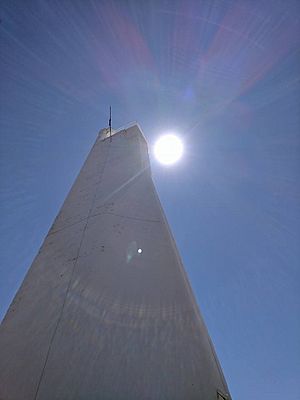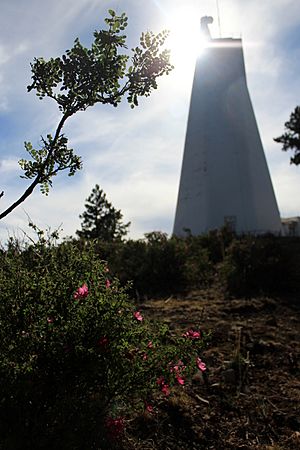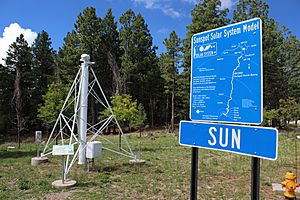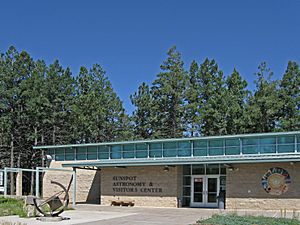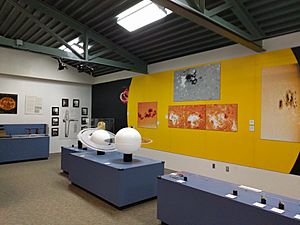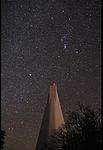Sunspot Solar Observatory facts for kids
| Established | 1947 |
|---|---|
| Research type | basic |
|
Field of research
|
Solar Physics, Space Weather |
| Director | James McAteer |
| Staff | 12 |
| Address | Highway 6563,, Sunspot, NM, 88349, USA |
| Location | Sunspot, New Mexico, USA 32°47′18″N 105°49′10″W / 32.7882°N 105.8195°W |
| 88349 | |
| Affiliations | New Mexico State University |
|
Operating agency
|
AURA, NSF |
The Sunspot Solar Observatory (SSO) is a special place where scientists study the Sun. It is an astronomical observatory located in Sunspot, New Mexico. The observatory is managed by New Mexico State University (NMSU) and the National Solar Observatory (NSO).
Scientists at Sunspot learn about the Sun and how it affects space weather. The observatory is in the Sacramento Mountains, about 18 kilometers (11 miles) south of Cloudcroft. You can even visit the observatory! They offer guided tours for the public.
Contents
Exploring the Sunspot Solar Observatory
The Sunspot telescope facility is found in Sunspot, New Mexico. It is part of the Lincoln National Forest. This area covers about 250 acres (100 hectares). It is managed by the U.S. Forest Service.
The observatory was first set up by the U.S. Air Force in 1950. Later, in 1976, it was given to the National Science Foundation (NSF). It was once known as the Sacramento Peak Observatory. Since 2018, the Sunspot Solar Observatory has handled all scientific research and public visits.
Scientists and staff from Sunspot Solar Observatory work in different places. They are in Sunspot, at New Mexico State University in Las Cruces, and with other groups around the world.
Amazing Telescopes at Sunspot
The most important telescope at Sunspot is the Richard B. Dunn Solar Telescope (DST). It used to be called the Vacuum Tower Telescope. This telescope helps scientists see very fine details on the Sun.
The Sunspot Solar Observatory has four other telescopes too.
- The John W. Evans Solar Facility was built in 1952. It used to study the Sun's outer atmosphere, called the corona. This helped predict future solar cycles.
- An Antarctic Mount telescope is near the Visitor's Center. It sends light into the center for visitors to see. This telescope was once used in Antarctica.
Visiting the Sunspot Astronomy Center
The Sunspot Astronomy and Visitor Center offers a fun way to learn about space. It has activities, displays, and exhibits. New Mexico State University runs the center.
You can take guided tours of the observatory and telescopes on Saturdays and Sundays. Self-guided tours are also available at other times. The Visitor Center has exhibits about the Dunn Solar Telescope. It also features the Apache Point Observatory and the Lincoln National Forest.
A Brief History of Sunspot
The idea for the Sunspot Solar Observatory began during World War II. The military needed to understand the Sun better. This was because solar activity affected radio communication. In 1940, the High Altitude Observatory (HAO) was started in Colorado. It was built to study the Sun.
Scientists like Walter Orr Roberts realized that clouds often blocked their view of the Sun. They needed a second observatory in a different location. This would allow them to study the Sun all year long. The U.S. Air Force decided to help fund a new solar observatory.
In 1947, a search began for the best place. They needed a spot with clear skies and good viewing conditions. They found the Sacramento Mountains in New Mexico. This area was perfect. It was high enough for clear views but also easy to reach.
By 1948, the Air Force officially decided to build the observatory at Sacramento Peak. They wanted a complete facility for observing, analyzing, and studying the Sun.
Amazing Views from Sunspot
From the western side of Sacramento Peak, you can see far and wide. You can spot the Apache Point Observatory and Sloan Digital Sky Survey telescopes. The white gypsum of White Sands National Park stands out against the desert.
On a clear day, you might even see cities like El Paso, Texas, and Juarez, Mexico. You can also see north to the Trinity test site. The overlook is also a great spot to watch rocket launches from White Sands Missile Range.
Gallery


